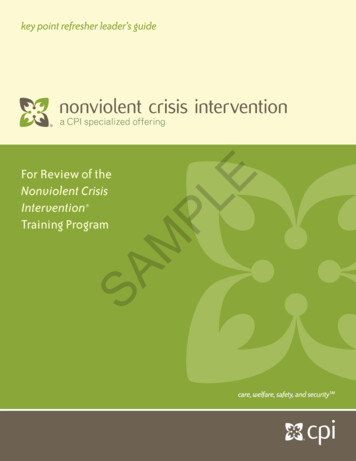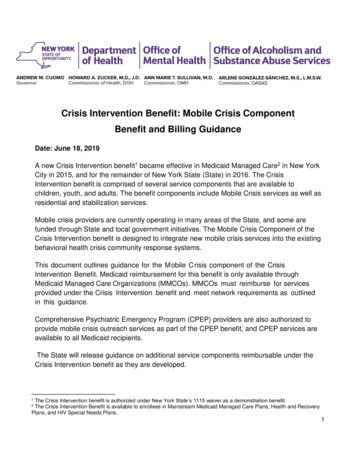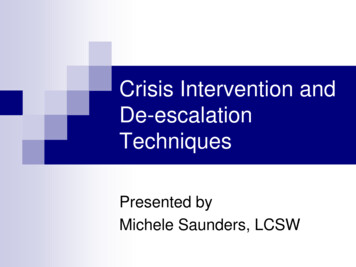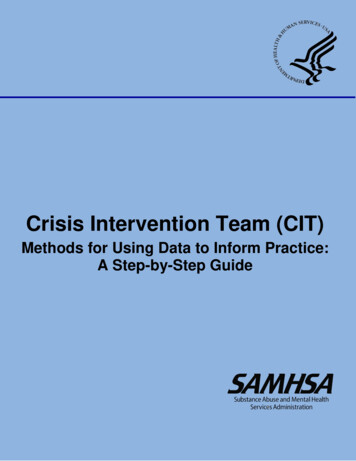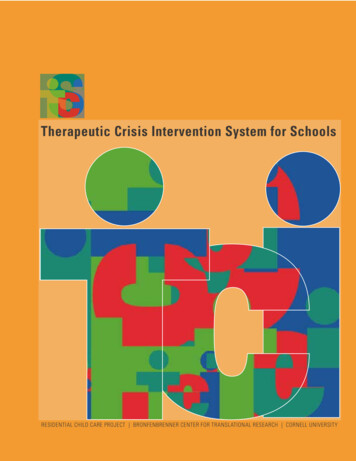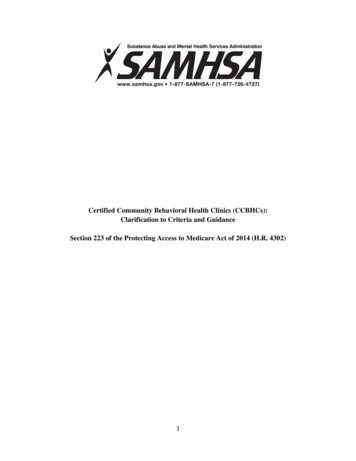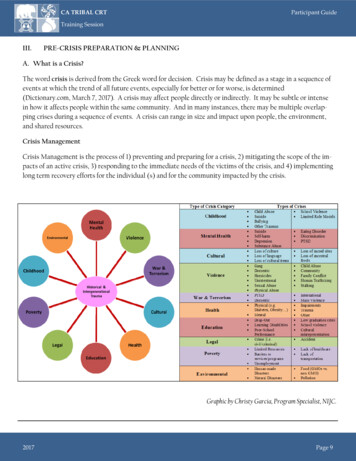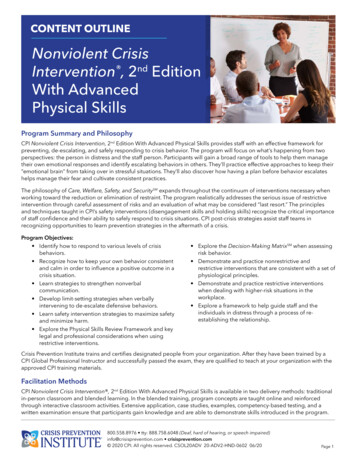
Transcription
CONTENT OUTLINENonviolent CrisisIntervention , 2nd EditionWith AdvancedPhysical SkillsProgram Summary and PhilosophyCPI Nonviolent Crisis Intervention, 2nd Edition With Advanced Physical Skills provides staff with an effective framework forpreventing, de-escalating, and safely responding to crisis behavior. The program will focus on what’s happening from twoperspectives: the person in distress and the staff person. Participants will gain a broad range of tools to help them managetheir own emotional responses and identify escalating behaviors in others. They’ll practice effective approaches to keep their“emotional brain” from taking over in stressful situations. They’ll also discover how having a plan before behavior escalateshelps manage their fear and cultivate consistent practices.The philosophy of Care, Welfare, Safety, and SecuritySM expands throughout the continuum of interventions necessary whenworking toward the reduction or elimination of restraint. The program realistically addresses the serious issue of restrictiveintervention through careful assessment of risks and an evaluation of what may be considered “last resort.” The principlesand techniques taught in CPI’s safety interventions (disengagement skills and holding skills) recognize the critical importanceof staff confidence and their ability to safely respond to crisis situations. CPI post-crisis strategies assist staff teams inrecognizing opportunities to learn prevention strategies in the aftermath of a crisis.Program Objectives: Identify how to respond to various levels of crisisbehaviors. Recognize how to keep your own behavior consistentand calm in order to influence a positive outcome in acrisis situation. Learn strategies to strengthen nonverbalcommunication. Develop limit-setting strategies when verballyintervening to de-escalate defensive behaviors. Learn safety intervention strategies to maximize safetyand minimize harm. Explore the Physical Skills Review Framework and keylegal and professional considerations when usingrestrictive interventions. Explore the Decision-Making MatrixSM when assessingrisk behavior. Demonstrate and practice nonrestrictive andrestrictive interventions that are consistent with a set ofphysiological principles. Demonstrate and practice restrictive interventionswhen dealing with higher-risk situations in theworkplace. Explore a framework to help guide staff and theindividuals in distress through a process of reestablishing the relationship.Crisis Prevention Institute trains and certifies designated people from your organization. After they have been trained by aCPI Global Professional Instructor and successfully passed the exam, they are qualified to teach at your organization with theapproved CPI training materials.Facilitation MethodsCPI Nonviolent Crisis Intervention , 2nd Edition With Advanced Physical Skills is available in two delivery methods: traditionalin-person classroom and blended learning. In the blended training, program concepts are taught online and reinforcedthrough interactive classroom activities. Extensive application, case studies, examples, competency-based testing, and awritten examination ensure that participants gain knowledge and are able to demonstrate skills introduced in the program.800.558.8976 tty: 888.758.6048 (Deaf, hard of hearing, or speech impaired)info@crisisprevention.com crisisprevention.com 2020 CPI. All rights reserved. CSOL20ADV 20-ADV2-HND-0602 06/20Page 1
Nonviolent Crisis Intervention , 2nd Edition With Advanced Physical Skills Content OutlineDay 1 – Training Content OutlineTRAININGCOMPONENTIntroductionBlended CourseLEARNING INTENTEstablish the learning expectations and guidelinesfor the training. Relate the impact of crisis behavior toparticipants’ experiences in the workplace.Time NeededClassroomTime NeededONLINECLASSROOM6 minutes15 minutes50 minutes18 minutes15 minutes65 minutes11 minutes15 minutes50 minutes14 minutes30 minutes75 minutesParticipants will: Evaluate the impact of fear and anxiety whenmanaging a crisis and making decisions. Explore the concept of behavior as communication.Module 1:The CPI CrisisDevelopmentModelSMIdentify behavior using the Crisis DevelopmentModelSM and apply staff approaches most effective inresponding at each behavior level to prevent furtherescalation.Participants will: Use the Crisis Development Model to identifybehaviors that indicate an escalation of behavior. Learn appropriate and effective staff approaches tocrisis behavior.Module 2:IntegratedExperienceExplore underlying causes of behavior, recognize theneed to maintain consistent, calm behavior in a timeof crisis, and understand how the behavior of oneperson impacts the behavior of others.Participants will: Assess how the behavior of one person impacts thebehavior of others. Identify causes of behavior and how staff maypositively impact outcomes. Recognize the need to maintain professionalismthrough Rational Detachment in the face ofescalating behaviors.Module 3:CommunicationSkillsPractice communication strategies and observe howdifferent approaches positively and/or negativelyimpact an individual’s behavior.Participants will: Recognize how communication skills are importantfor building, strengthening, and maintainingrapport with individuals in crisis. Practice awareness of position, posture, andproximity in the use of the Supportive StanceSM. Practice a range of communication skills at differentlevels of the Crisis Development Model includinglistening with empathy and nonverbal, verbal, andparaverbal skills.Page 2
Nonviolent Crisis Intervention , 2nd Edition With Advanced Physical Skills Content OutlineDay 1 and 2 – Training Content OutlineTRAININGCOMPONENTModule 4:Respondingto DefensiveBehaviorsBlended CourseTime NeededLEARNING INTENTIdentify defensive behaviors in crisis situations usingthe Verbal Escalation ContinuumSM. Use specificverbal patterns when de-escalating a crisis to developa range of responses. Identify how to prepare for adifficult conversation.ClassroomTime NeededONLINECLASSROOM18 minutes40 minutes90 minutes10 minutes25 minutes60 minutesParticipants will: Identify different levels of defensive behavior in theVerbal Escalation Continuum. Examine and apply effective interventions fordefensive behaviors. Identify steps to prepare for a difficult conversation.Module 5: SafetyInterventionsPractice and apply skills needed to keep oneself safewhen crisis escalates to risk behavior. Apply principlesfor using a coordinated and collaborative approach.Participants will: Examine environmental factors and approachesused to maintain safety. Determine how strikes can be managed or avoided. Apply how and when to use a coordinatedapproach.[End of Day 1 6.5 hours] Define nonrestrictive intervention strategies.DAY 1SafetyInterventions:DisengagementSkillsLearn how to respond effectively when an individualis in risk behavior. Build the confidence of staff intheir ability to keep themselves and others safe usingdisengagement skills.DAY 2n/a85 minutes90 minutes11 minutes5 minutes25 minutesParticipants will: Practice applying disengagement skills for low-,medium-, and high-risk situations. Build confidence in keeping themselves and otherssafe in a crisis situation.Module 6:Introductionto RestrictiveInterventionsIdentify restrictive interventions and explore the keylegal and professional considerations when usingrestrictive interventions. Explore the Physical SkillsReview Framework.Participants will: Recognize that any restrictive interventions shouldbe used as a last resort and if used, it should bereasonable, proportionate, and least restrictive tomaximize safety and minimize harm.Page 3
Nonviolent Crisis Intervention , 2nd Edition With Advanced Physical Skills Content OutlineTRAININGCOMPONENTBlended CourseTime NeededLEARNING INTENTONLINEOrganize thinking regarding the risks associated withdifferent behaviors, encouraging critical analysis andrational reasoning in response decisions.Time NeededCLASSROOMDAY 1Module 7:Decision MakingClassroomDAY 210 minutes15 minutes45 minutesn/a110 minutes150 minutes10 minutes15 minutes45 minutes12 minutes15 minutes35 minutes2 HoursTotal6.5 HoursTotal6.5 Hours/per DayParticipants will: Categorize risk behaviors, considering likelihoodand severity of potential outcomes. Utilize the Decision-Making MatrixSM as a mentalmodel for situational or behavioral risk assessment.SafetyInterventions:Holding SkillsLearn how to respond effectively when an individualis in risk behavior. Build the confidence of staff intheir ability to keep themselves and others safe usingrestrictive holding skills.Participants will: Practice applying restrictive holding skills for low-,medium-, and high-risk situations. Build confidence in keeping themselves and otherssafe in a crisis situation.Module 8:Post-CrisisIntroduce the COPING ModelSM, which is a frameworkto help guide staff and the individuals in distressthrough the process of establishing TherapeuticRapport after a crisis.Participants will: Explore Tension Reduction and how to re-establishthe relationship after a crisis event. Describe two key aspects of post-crisismanagement: support and learning.Conclusion andAssessmentReflect on new learning and complete an action plan.Revisit program values, person-centered care, and aculture of safety.Participants will: Reflect on how to apply the skills learned whenreturning to work. Complete an online quiz prior to classroomtraining. Complete a classroom test and training evaluation.Total TimePage 4
Nonviolent Crisis Intervention , 2nd Edition With Advanced Physical Skills Content OutlineDay 3 – Advanced Physical Skills Content OutlineClassroomTRAININGCOMPONENTLEARNING INTENTIntroductionWelcome, review, and discussion.30 minutesUnderstanding theRisks of PhysicalRestraintsExplore how to support and promote positive practice and to ensure thatrestrictive interventions are used as part of a commitment to Care, Welfare, Safety,and Security. Physical interventions should always be a last resort—there mustbe no safer alternative. They should be reasonable, proportionate, and leastrestrictive.30 minutesTime NeededParticipants will learn about: Potential risks associated with the use of restrictive interventions. Factors contributing to restraint-related deaths. Best practice indicators that should shape practice to reduce avoidablerestraints and minimize the risks of restraint when such measures areunavoidable. Opt-Out SequenceSM, an active decision-making framework to enable staff toassess the continued risks in order to minimize the duration of restraints. Risks of restraints: warning signs and corrective actions.Safety Interventions:Disengagement SkillsReview and ExpansionLearn how to respond effectively when an individual is in risk behavior. Buildthe confidence of staff in their ability to keep themselves and others safe usingdisengagement skills.30 minutesParticipants will: Review and practice applying disengagement skills for low-, medium-, andhigh-risk situations. Build confidence in keeping themselves and others safe in a crisis situation. Apply principles of disengagement to a variety of realistic situations.Safety Interventions:Holding Skills Reviewand ExpansionLearn how to respond effectively when an individual is in risk behavior. Buildthe confidence of staff in their ability to keep themselves and others safe usingphysical holding skills.60 minutesParticipants will: Practice applying physical holding skills for low-, medium-, and high-risksituations. Build confidence in keeping themselves and others safe in a crisis situation. Learn how to add staff to assist with holding skills. Review frameworks to convey reasoning for the level of intervention used as aresponse to risk presented.Emergency FloorHolds: SupineLearn how to respond effectively when an individual is in risk behavior. Buildthe confidence of staff in their ability to keep themselves and others safe usingEmergency Floor Hold: Supine.60 minutesParticipants will learn how to: Safely manage an individual who is moving from a standing to seated or supineposition on the floor. Practice applying the principles of holding for Emergency Floor Hold: Supine. Review frameworks to convey reasoning for the level of intervention used as aresponse to risk presented.Page 5
Nonviolent Crisis Intervention , 2nd Edition With Advanced Physical Skills Content OutlineClassroomTRAININGCOMPONENTLEARNING INTENTEmergency FloorHolds: SupportedProneLearn how to respond effectively when an individual is in risk behavior. Buildthe confidence of staff in their ability to keep themselves and others safe usingEmergency Floor Hold: Supported Prone.Time Needed60 minutesParticipants will learn how to: Safely manage an individual who is moving from a standing to a kneeling orlying position on the floor. Practice applying the principles of holding for Emergency Floor Hold:Supported Prone. Review frameworks to convey reasoning for the level of intervention used as aresponse to risk presented.Seated Holding:Children’s ControlPositionSMLearn how to respond effectively when an individual is in risk behavior. Buildthe confidence of staff in their ability to keep themselves and others safe usingSeated Holding: Children’s Control PositionSM.15 minutesParticipants will learn how to: Practice applying the principles of Children’s Control PositionSM when anindividual is seated in a chair.Scenario PracticeActivitiesPractice and rehearse skills learned in the program through scenarios simulating“real-world” situations.60 minutesLearners will participate in crisis simulations that require them to: Assess the prevailing risk presented by an individual in distress. Apply appropriate intervention skills learned in the program. Utilize corrective actions in response to warning signs of physical and/or psychological distress occurring during the application of physicalinterventions. Debrief after physical interventions using the COPING Model. Provide peer-to-peer feedback.Wrap UpReview and discussion of learning that took place during the day.15 minutesTotal Time6 HoursPage 6
Nonviolent Crisis Intervention , 2nd Edition With Advanced Physical Skills Content OutlineCPI Instructor Certification Program ComponentsPROGRAM HOURS – BLENDED DELIVERYThe 26.5-hour CPI Instructor Certification Program includes: PART 1: Participation in 2 hours of Nonviolent Crisis Intervention , 2nd Edition Training online. PART 2: Participation in 12.5 hours of Nonviolent Crisis Intervention , 2nd Edition With Advanced Physical Skillsclassroom activities. PART 3: Participation in 12 hours of Certified Instructor training that includes:————Preparing to teach the adult learnerComprehensive Instructor training practicumManaging the Certified Instructor roleCertified Instructor examination and recognitionNote: On days 3–5, more breaks will be given as the content becomes more physically and mentally demanding;therefore the required time in classroom is 8 hours, yet the contact hours will decrease due to more break time.PROGRAM HOURS – CLASSROOM DELIVERYThe 31-hour CPI Instructor Certification Program includes: PART 1: Participation in 19 hours of Nonviolent Crisis Intervention , 2nd Edition With Advanced Physical Skillsclassroom activities. PART 2: Participation in 12 hours of Certified Instructor training that includes:————Preparing to teach the adult learnerComprehensive Instructor training practicumManaging the Certified Instructor roleCertified Instructor examination and recognitionNote: On days 3–5, more breaks will be given as the content becomes more physically and mentally demanding;therefore the required time in classroom is 8 hours, yet the contact hours will decrease due to more break time.The training components below outline the Train-the-Trainer content for Nonviolent Crisis Intervention , 2nd EditionWith Advanced Physical Skills.Page 7
Nonviolent Crisis Intervention , 2nd Edition With Advanced Physical Skills Content OutlineDay 4 – Train the TrainerTRAINING COMPONENTDESCRIPTIONTRAINING TIMEIntroductionOrients participants to becoming a CPI Certified Instructor.30 minutesParticipants will: Discussion and InteractiveActivity Identify Instructor Association’s mission, terminology, andmembership benefits and support. Discuss the role of a Certified Instructor.Safety InterventionsTeaching Practiceand Assessment –Disengagement SkillsAssesses proficiency in teaching Safety Interventions —Disengagement Skills.Participants will: Review key principles.90 minutes Lecture, discussion,demonstration, practice, andpeer teaching Apply an understanding of these principles. Demonstrate ability to teach disengagement skills. Identify group facilitation techniques that can best engagestaff and enhance learning.Safety InterventionsTeaching Practice andAssessment – HoldingSkillsAssesses Instructor candidates’ proficiency in teachingconcepts and strategies of CPI’s Safety Interventions – HoldingSkills.Participants will:90 minutes Lecture, discussion,demonstration, practice, andpeer teaching Review key principles.– Apply knowledge of key principles when answeringquestions about holding skills.– Review Physical Skills Review Framework (SEAT).– Review Opt-Out Sequence. Demonstrate proficiency teaching holding skills.Safety InterventionsTeaching Practice andAssessment – AdvancedPhysical SkillsAssesses Instructor candidates’ proficiency in teachingconcepts and strategies of CPI’s Safety Interventions –Advanced Physical Skills.Participants will:120 minutes Lecture, discussion,demonstration, practice, andpeer teaching Review key principles.– Apply knowledge of key principles when answeringquestions about Advanced Physical Skills.– Review Physical Skills Review Framework (SEAT).– Review Opt-Out Sequence. Demonstrate proficiency teaching Advanced Physical Skills.Program QualityStandardsIdentifies benefits of membership in the CPI InstructorAssociation. Explores roles and responsibilities of the CertifiedInstructor.30 minutes Facilitated lecture andinteractive group activityParticipants will: Learn the components and requirements of the InstructorExcellence Renewal Process. Understand the importance of training as an ongoingprocess. Become familiar with the resources, processes, andprocedures for initial and refresher training programs.Total Time6 HoursPage 8
Nonviolent Crisis Intervention , 2nd Edition With Advanced Physical Skills Content OutlineDay 5 – Train the TrainerTRAINING COMPONENTDESCRIPTIONTRAINING TIMEInstructional Goals andFacilitation StrategiesDevelops awareness and understanding of effective methodsfor teaching the adult learner.60 minutesParticipants will: Instructor-led discussion andexploratory activity Determine best practice for organizing training materials andmaintaining program continuity and consistency. Gain an understanding of CPI learning modalities (blendedand classroom). Principles and tips for training the adult learner. How to use a variety of activity types and facilitationmethods. Become familiar with the Instructor Guide, Workbook andElectronic Presentation.Purpose of ContentReviews each module of the program looking at it throughthe lens of an instructor and focusing on the purpose andobjectives of each module.Participants will:60 minutes Instructor-led discussion andsmall-group experientialactivity Understand the learning objectives of each module. Understand the structure of the program and how to connectmodules for ease of learning.Facilitation Practice/Practicum AssignmentApplies facilitation strategies to assigned content area.180 minutesParticipants will: Peer teaching and feedback Demonstrate relevant facilitation techniques. Practice customizing assigned content to work setting, usinginstructional guidance. Using the CPI Verbal Intervention Checklist, Instructor willevaluate participants in their successful application of verbalintervention skills using a role-play activity.Final Written ExaminationAssesses comprehensive understanding of all programcontent.Participants will:30 minutes Test administration andparticipant evaluations Describe the relevance of implementing training as aprocess relative to program content and skills. Provide evidence of their commitment to the programphilosophy of Care, Welfare, Safety, and Security.Recognition ofCertification Formally recognizes successful completion of all participantswho have earned certification privileges.Total Time30 minutes Closing remarks andpresentation of certification6 HoursPage 9
Nonviolent Crisis Intervention , 2nd Edition With Advanced Physical Skills Content OutlineTraining MaterialsAfter gaining your certification, you are eligible to teach, and you’ll receive the following CPI training materials. Participant Workbook: Each training participant receives a CPI Nonviolent Crisis Intervention , 2nd Edition WithAdvanced Physical Skills Participant Workbook to help enhance learning, organize the participant’s thoughtsregarding concepts taught in the program, and serve as a valuable reference tool following the program. Instructor Guide: Those who successfully complete the Instructor Certification Program receive a comprehensiveCPI Nonviolent Crisis Intervention , 2nd Edition With Advanced Physical Skills Instructor Guide to assist them infacilitating thorough and effective staff training that is consistent with program quality standards, policies, andprocedures. Instructor Kit: All participants who successfully complete the Instructor Certification Program receive an InstructorKit. This kit includes resource materials necessary to teach their first CPI Nonviolent Crisis Intervention , 2nd EditionWith Advanced Physical Skills Training.Nonviolent Crisis Intervention , 2nd Edition WithAdvanced Physical Skills Training OptionsCPI VERBALINTERVENTION TRAININGCPI NONVIOLENT CRISISINTERVENTION 2ND EDITIONTRAININGCPI NONVIOLENT CRISISINTERVENTION , 2ND EDITION WITHADVANCED PHYSICAL SKILLSPrevention and verbalde-escalation strategiesnnnSafety interventions –disengagement skillsnnnTools for decision makingnnSafety interventions –holding skillsnnTools to manage high-risk,complex behaviorsnAdvanced physical skillsnTraining Options:Online ClassroomWith Disengagement:1.5 hours online 4 hours in classWithout Disengagement:1.5 hours online 2.5 hoursTraining Options:Classroom Onlyn/a2 hours online 6.5 hours in class2 hours online 16 hours in class13 hours18 hoursPage 10
Nonviolent Crisis Intervention , 2nd Edition With Advanced Physical Skills Content OutlinePlease note: Organizational and participant-specific needs will impact timing. When classroom time is reduced, practice andapplication will be limited. In these situations, informal follow-up training opportunities will strengthen staff skillsand learning while improving performance. Policy/procedure and participant-specific needs should determine the program option delivered. You are strongly encouraged to maintain a record of each program you’ve facilitated and the names of theparticipants in those programs.800.558.8976 tty: 888.758.6048 (Deaf, hard of hearing, or speech impaired)info@crisisprevention.com crisisprevention.com 2020 CPI. All rights reserved. CSOL20ADV 20-ADV2-HND-0602 06/20Page 11
their ability to keep themselves and others safe using disengagement skills. Participants will: Practice applying disengagement skills for low-, medium-, and high-risk situations. Build confidence in keeping themselves and others safe in a crisis situation. n/a 85 minutes 90 minutes Module 6: Introduction to Restrictive Interventions
